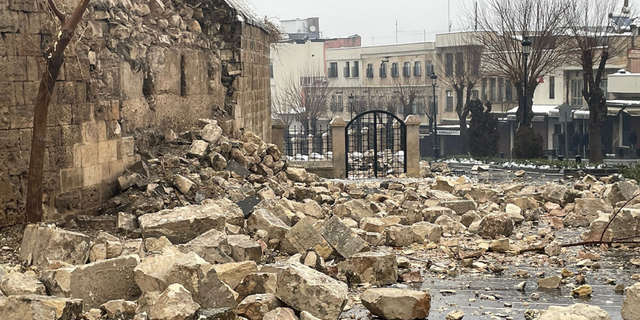The 7.8-magnitude earthquake that claimed more than 2,500 lives after hitting Turkey and Syria destroyed parts of the Roman-era Gaziantep castle, pictures show.
Photos taken on Monday of the hill fort in southern Turkey show parts of its walls crumbled and stones scattered in piles.
“The iron railings around the castle were scattered on the surrounding sidewalks. The retaining wall next to the castle also collapsed,” Turkey’s state-run Anadolu News Agency wrote in a report. “Large cracks have been observed in some ramparts.
“On the other hand, the dome and eastern wall of the historic Şirvani Mosque, which is located next to the castle and is said to have been built in the 17th century, partially collapsed,” the report added.
TURKEY, SYRIA EARTHQUAKE: BIDEN, NETANYAHU AND OTHER WORLD LEADERS OFFER HELP AFTER THOUSANDS OF DEATHS

Damage is seen along the walls of Gaziantep Castle in Turkey on Monday. (Mehmet Akif Parlak/Anadolu Agency via Getty Images)
Gaziantep Castle was first built as a watchtower in the Roman period from the 2nd to the 4th century before taking its present form in the 6th century during the rule of the Byzantine emperor Justinian, nicknamed “the architect of castles”, according to the Turkish Museums website.
TURKEY EARTHQUAKE DEVASTATION CAPTURED ON VIDEO

The stones are scattered across the grounds of Gaziantep Castle in Turkey. (Mehmet Akif Parlak/Anadolu Agency via Getty Images)
Even the castle, which has 12 towers, has been remodeled throughout history by the Ottomans, the website adds.
CLICK HERE TO GET THE FOX NEWS APP

Gaziantep Castle dates back to the 2nd century. (Mehmet Akif Parlak/Anadolu Agency via Getty Images)
The most recent renovation was in the early 2000s, according to The Associated Press.
The castle is now a museum which “illustrates the resistance struggle of the people of Antep against the French and English occupation, the battlefields, the heroes who fight in these battlefields, the attacks, as well as the actions and difficulties that people had to deal with,” regional tourism officials say.
